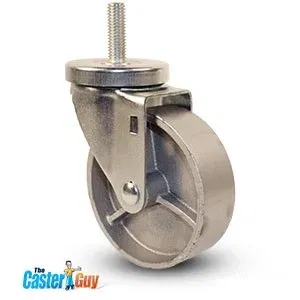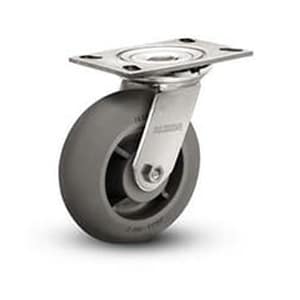When it comes to selecting the right casters for your furniture or equipment, understanding the differences between hard and soft casters is crucial. The choice between hard and soft casters can significantly affect the mobility, functionality, and longevity of your items. In this comprehensive guide, The Caster Guy will explore the key differences, benefits, and ideal use cases for hard and soft casters.
What Are Hard Casters?

Steel Caster
Hard casters are typically made from materials such as plastic, metal, or a composite. These materials provide a durable, smooth rolling experience on hard surfaces like wood, tile, or concrete. Hard casters are known for their strength and longevity, making them a popular choice for heavy-duty applications.
Key Characteristics of Hard Casters
- Durability: Made from robust materials, hard casters are designed to withstand significant weight and wear.
- Low Rolling Resistance: They roll easily on hard surfaces, reducing the effort needed to move heavy items.
- Less Cushioning: Hard casters offer minimal shock absorption, which can lead to increased noise and potential damage to sensitive flooring.
Ideal Applications for Hard Casters
Hard casters are best suited for environments where durability and easy mobility are essential. Some common applications include:
- Office chairs on carpeted floors
- Industrial equipment on concrete floors
- Furniture on hardwood or tiled surfaces
What Are Soft Casters?

Soft Rubber Caster
Soft casters are made from materials such as rubber, polyurethane, or soft plastic. These materials provide a gentler touch on surfaces, offering more grip and cushioning compared to hard casters. Soft casters are designed to protect delicate flooring from scratches and reduce noise during movement.
Key Characteristics of Soft Casters
- Floor Protection: Soft casters are less likely to damage sensitive flooring, such as hardwood, laminate, or linoleum.
- Increased Traction: The softer materials provide better grip, preventing slips and enhancing control.
- Noise Reduction: Soft casters offer quieter operation, making them ideal for noise-sensitive environments.
Ideal Applications for Soft Casters
Soft casters are ideal for settings where floor protection and noise reduction are priorities. Common applications include:
- Office chairs on hardwood or linoleum floors
- Medical equipment in hospitals
- Furniture in residential settings
Comparing Hard and Soft Casters
To help you decide which type of caster is right for your needs, let’s compare hard and soft casters across several important factors:
1. Surface Compatibility
Hard Casters: Best for hard, non-carpeted surfaces. They can damage soft floors like hardwood or laminate.
Soft Casters: Ideal for protecting soft or delicate floors. They may not roll as smoothly on thick carpet.
2. Weight Capacity
Hard Casters: Generally have a higher weight capacity, making them suitable for heavy-duty applications.
Soft Casters: Usually have a lower weight capacity but are sufficient for most residential and light commercial uses.
3. Noise Level
Hard Casters: Can be noisy on hard surfaces, especially if the surface is uneven or damaged.
Soft Casters: Quieter due to their shock-absorbing properties, making them ideal for quiet environments.
4. Maneuverability
Hard Casters: Offer low rolling resistance, making it easy to move heavy items with minimal effort.
Soft Casters: Provide better traction and control, particularly on smooth or slippery surfaces.
5. Durability
Hard Casters: Highly durable and can withstand significant wear and tear.
Soft Casters: While durable, they may wear down faster than hard casters under heavy loads or rough surfaces.
Making the Right Choice
When choosing between hard and soft casters, consider the specific requirements of your application:
- Floor Type: Match the caster material to your flooring to prevent damage and ensure smooth operation.
- Load Capacity: Ensure the caster can handle the weight of the items you’ll be moving.
- Noise Considerations: Opt for soft casters if noise reduction is a priority.
- Maneuverability: Choose hard casters for easy rolling on hard surfaces, or soft casters for better grip and control.
Conclusion
Both hard and soft casters have their unique advantages and ideal use cases. By understanding the differences and evaluating your specific needs, you can select the right casters to enhance the mobility and functionality of your furniture or equipment. The Caster Guy is here to help you make the best choice for your applications, ensuring you get the performance and durability you need.

